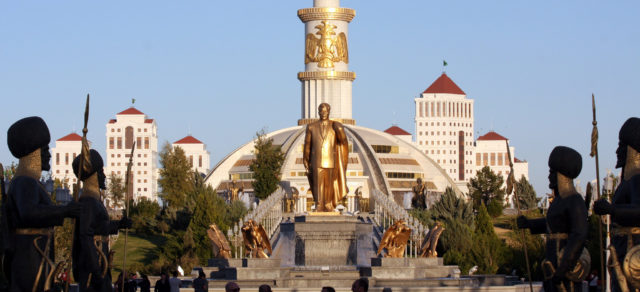
Little-Known Turkmenistan About to Become Known for Its Big Problems
Publication: Eurasia Daily Monitor Volume: 14 Issue: 18
By:

No post-Soviet republic is so little known beyond its borders as Turkmenistan. This relative obscurity internationally is the result of three legacies: its poverty in Soviet times; its relatively tiny cohort of intellectuals who might have called attention to the country; and perhaps most importantly, Turkmenistan’s lack of a unified national identity, a feature that has led many scholars to call it “ ‘a nation’ of tribes” (Sh. Kadyrov, “Natsiya” plemen, Moscow, 2003; and Kadyrov, Mnogolikiy Turmenchilik: etnograficheskiye ocherki, ponyatia i terminy, Moscow, 2010). And the few who have talked about Turkmenistan at all often dismissed it as “a Stalinist Disneyland” because of the often comic opera quality of the vicious authoritarianism of its presidents (Lutz Kleveman, The New Great Game: Blood and Oil in Central Asia, New York, 2004).
But on the occasion of the re-election of President Gurbanguly Berdimuhamedow (who, not unexpectedly, received almost 98 percent of the vote, on February 12), three outside specialists—Andrey Kazantsev of MGIMO (Russiancouncil.ru, February 9), Yaroslava Krivtsun, a Ukrainian foreign policy expert (Apostrophe.ua, February 12), and Petr Bologov, a Russian commentator at the Carnegie Moscow Center (Carnegie.ru, February 13)—have offered their assessments of Turkmenistan’s development prospects. They are not encouraging and suggest that those who have ignored that country in the past will not be able to do so in the near future.
All three analysts suggest that there are many reasons to be concerned about the problems that Turkmenistan faces but point out that any accurate assessment of just how serious and immediate these problems are is hampered by the lack of reliable statistics from Ashgabat and the brutal censorship the Turkmenistani government imposes on its media. According to Kazantsev, as far as access to information is concerned, “Turkmenistan is comparable to North Korea” (Russiancouncil.ru, February 9). Nonetheless, there are five obvious causes for concern and perhaps even alarm when it comes to this reclusive Central Asian republic.
First of all, Turkmenistan continues to experience explosive demographic growth, with the number of births outnumbering deaths by more than three to one, a trend that means the median age of the country’s population is 29. That places enormous burdens on the economy to provide jobs. But because Ashgabat does not permit its people to become guest workers in Russia or elsewhere, Turkmenistan lacks both the safety valve and remittance income that such departures give other Central Asian countries. As a result, there is massive, if hidden unemployment among the young—one of the most powerful indicators of a danger of extremist violence.
Second, Turkmenistan has suffered from the falling price of natural gas, its most important export, not only directly but indirectly because its pipeline to China was financed by a loan from Beijing, something Ashgabat is now finding difficult to service. The problem is compounded by the fact that other pipelines the country would like to build, via Afghanistan, Iran, or the Caucasus, also face serious problems and delays. Squeezed in this way, Turkmenistan’s government is cutting back the social welfare payments that it has been using to keep popular unhappiness at bay.
Third, Turkmenistan, which had been largely free of Islamist radicalism for most of the post-Soviet period, has experienced a major escalation on that front over the last three years. This was largely because of the decision of Turkmens living in Afghanistan to shift their support from the Taliban to the more extreme Islamic State forces. Because many of the Turkmens in Afghanistan retain their tribal identities in the same way that Turkmens in Turkmenistan do, radicalized individuals can appeal tribe-to-tribe across the border, something that had earlier been impossible for Salafists from Afghanistan.
Fourth, Ashgabat faces a serious security threat from the south, a threat that it has tried to counter by seeking to improve its armed forces (see EDM, February 26, 2014; March 13, 2015; March 31, 2015). But reports in the Turkmen media suggest that the threat is increasing more rapidly than Ashgabat’s forces are able to counter it, especially because many of those drafted into its army do not want to serve and are powerfully affected by the ideological trends in Islam that the country’s government seeks to oppose.
And fifth, Turkmenistan takes great pride in its non-aligned status, something that the United Nations has officially recognized. But that means that it cannot count on Russia or anyone else to help defend it in the event of an invasion by militant groups from the south. Many now doubt that Ashgabat will be able to maintain its neutrality or that, if there were a serious incursion from Afghanistan, Moscow would not intervene, despite what Ashgabat now says. Were that to happen, not only would Turkmenistan lose its non-aligned status, but the current brittle authoritarianism of its rulers would probably break down as well.
These three analysts believe that Turkmenistan is probably going to be able to muddle along for a time. But all of them see a “worst-case scenario,” in which the state collapses into chaos under an Islamist insurgency, as more likely than a “best-case” one—in which it manages to transform itself into the Kuwait or Qatar of Central Asia, as its president has declared. To the extent these gloomy predictions are right, a country many have ignored up to now will not permit anyone to ignore it for much longer.



